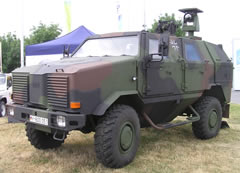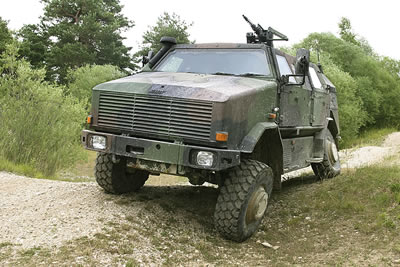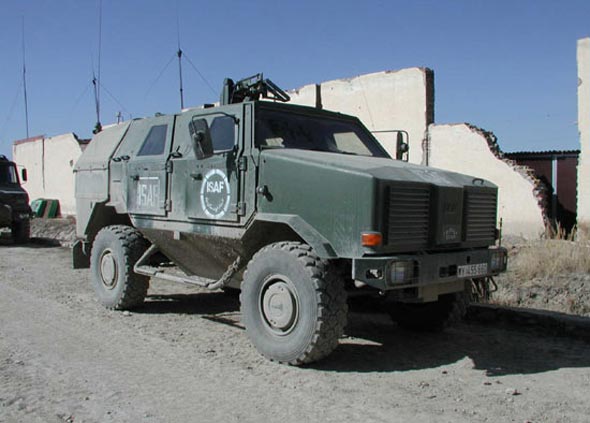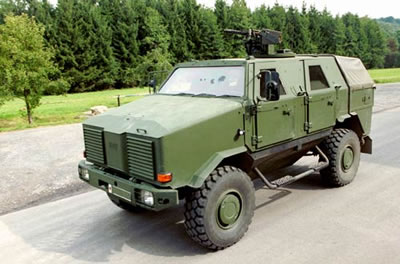The Dingo APV was designed to provide a safe and secure multi-purpose vehicle for military and peacekeeping operations. The Dingo 2 is an air transportable, armored mine-proof vehicle, based on a commercial Unimog U1550L chassis produced by DaimlerChrysler, designed for high mobility in any type of terrain.
 The vehicle is fitted with an armored cage protecting the passengers, engine compartment, fuel tank and cargo bay. The modular, repairable armor provides all-round protection against all types of hand-held weapons, as well as artillery fragments up to 155mm. In addition, the DINGO is fitted with an oblique “blast deflector” floor, providing crew protection against heavy anti-tank (AT), EFP (Explosive Formed Penetration) mines and anti-personnel (AP) mines. It is designed to travel at speeds of up to 100 km/h (62mph), has a range of 1000 km (621 miles), is air transportable by C-130 and C-160 aircraft and can be airlifted by CH47/CH53 helicopters.
The vehicle is fitted with an armored cage protecting the passengers, engine compartment, fuel tank and cargo bay. The modular, repairable armor provides all-round protection against all types of hand-held weapons, as well as artillery fragments up to 155mm. In addition, the DINGO is fitted with an oblique “blast deflector” floor, providing crew protection against heavy anti-tank (AT), EFP (Explosive Formed Penetration) mines and anti-personnel (AP) mines. It is designed to travel at speeds of up to 100 km/h (62mph), has a range of 1000 km (621 miles), is air transportable by C-130 and C-160 aircraft and can be airlifted by CH47/CH53 helicopters.
So far the German Army ordered 145 Dingo I and II vehicles for its rapid deployment units, currently operating with KFOR in Kosovo and Macedonia and with coalition forces in Afghanistan. Belgium also ordered 352 of the new Dingo III version, also known as Multi-Purpose Protected Vehicles (MPPV). Two versions of the Dingo 2 will be offered, with wheel bases of 3,250 (short version) and 3,850mm (long version), tailored for a variety of transport and carrier configurations designed for reconnaissance, command and control, ambulance, mission platform, forward air control and other missions.
The DINGO 2 is based on the Unimog 5000 chassis. The diesel powered vehicle is offered in two versions – the short (3.25m’ wheel base) and long (3.85m’ wheel base) which can carry eight fully equipped troops. The Dingo-2 can be fitted with an overhead weapon station, and has an integral collective NBC (nuclear, biological, chemical) protection and air-conditioning system. Other integral systems include GPS navigation, rear-view camera, ABS, as well as radio and internal communications systems.
 The vehicle has an authorized total weight of 9,200 kg for a payload of 1,200 kg plus five fully equipped soldiers. The German Bundeswehr is arming its Dingo version with an under-armor operated 7.62 mm machine gun. Alternatively, a .50 cal. machine gun or a 40-mm automatic grenade-launcher can be mounted on the same weapon station. The German Army requirement for Dingo is over 450 units which are expected to be the stretched version of the Dingo-2.
The vehicle has an authorized total weight of 9,200 kg for a payload of 1,200 kg plus five fully equipped soldiers. The German Bundeswehr is arming its Dingo version with an under-armor operated 7.62 mm machine gun. Alternatively, a .50 cal. machine gun or a 40-mm automatic grenade-launcher can be mounted on the same weapon station. The German Army requirement for Dingo is over 450 units which are expected to be the stretched version of the Dingo-2.
To date, Dingo 2 orders amount to over 200 vehicles. In 2005 the Bundeswehr ordered 52 vehicles and on June 29, 2006 KMW announced it is expecting additional 149 Dingo 2s orders, for a total of 109 million Euros. Belgium will also buy 200 Dingo 2 vehicles. Austria received 20 such vehicles in 2005.
 Textron Systems has secured local production license for a similar Dingo 2 vehicle in the US for domestic and foreign military sales contracts. The Israel Defense Forces has already secured funding in its five year plan (2005-2008) for the procurement of 60 Dingo-2 vehicles. Dingos were intended for operations in the West Bank, replacing existing locally manufactured light armored vehicles such as Sufa and Abir. The estimated cost per unit is $500,000. The IDF requested 103 vehicles which also reflect test vehicles and options for additional batches over the 60 originally planned. The total cost amounted to $99 million, to be financed by US military aid. However, following German opposition to the deal, the IDF procurement was suspended for indefinite time.
Textron Systems has secured local production license for a similar Dingo 2 vehicle in the US for domestic and foreign military sales contracts. The Israel Defense Forces has already secured funding in its five year plan (2005-2008) for the procurement of 60 Dingo-2 vehicles. Dingos were intended for operations in the West Bank, replacing existing locally manufactured light armored vehicles such as Sufa and Abir. The estimated cost per unit is $500,000. The IDF requested 103 vehicles which also reflect test vehicles and options for additional batches over the 60 originally planned. The total cost amounted to $99 million, to be financed by US military aid. However, following German opposition to the deal, the IDF procurement was suspended for indefinite time.
More recently in July 2006, the German opposition seem to have soften; sources in Germany indicated that the German parliament could waive its opposition and approve preliminary sales for testing. However, this may be too late, since Israel is currently considering heavier vehicles, including 4×4 heavily armored trucks,M-1117 ASV armored cars or even the new SandCat up-armored, Ford 350 radically modified and armored by Plasan Sasa, which offers the same protection but cost less than half of the German vehicle.





















